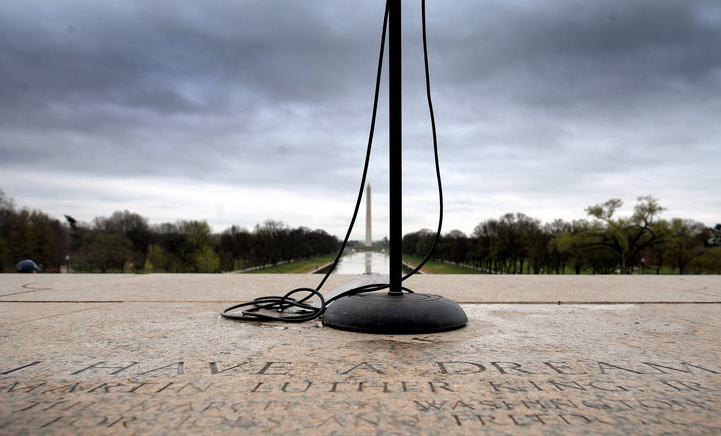This is the vantage point from which Dr. Martin Luther King, Jr., proclaimed his “Dream” in 1963 of a world in which “little black boys and little black girls will be able to join hands with the little white boys and white girls as sisters and brothers.” I have listened to King’s oration hundreds of times and I have published essays on that moment in history; and more, I have taught the speech in classes more times than I can remember and I never—not ever!—fail to be deeply affected by the sound and the power of the words. But all of that paled in comparison to standing in the exact spot that King stood, literally cast in the shadow of Lincoln and gazing out upon the broad vista of the National Mall with the reflecting pond leading one’s sight to the Washington Monument. The Mall was not entirely full on the day I was there, but I could easily imagine it packed with a quarter of a million people, sitting and standing in common cause for racial equality guided by King’s eloquent tones and his vision of a “beloved community.” It was a truly spiritual moment.
And then I saw this photograph in the Washington Post and it brought me up short. The clouds are a steely grey and somewhat foreboding, as they engulf the top of the Washington Monument and seem to be moving forward to enshroud the entire Mall, and by extension the nation that it stands in for. There is no sun, and so Lincoln’s shadow is nowhere to be seen. But most of all, there are no crowds of people—black, white, brown, yellow … —joining hands or otherwise; what we have instead is something of a civic and social void underscored by the lone microphone stand that substitutes metonymically for the absent King—the eloquent voice of our national social conscience. Shot straight on and from ground level the microphone stand is placed in linear perspective with the Washington Monument and seems to dwarf it in size. And what it made me consider is how seductive the romantic mythos of the National Mall can be with its magnificent views and enormous monuments, and yet how symbolically empty (and even ominous) that mythos can be when there is no one to speak for social justice or when there is no one there to listen.
Photo Credit: Tim Sloan-AFP/Getty Images

Another comment on the sky:
Interesting to see how the dark clouds seem to loom over the entire sky, except looking in the distance we find a break of sunlight across the horizon. Looking at this from a perspective of racial problems in America, it suggests that troubled times are here, but that there is hope somewhere, and it is almost inevitable. Even more interestingly, if there were a crowd on the mall looking to the podium, they would not see the sunlight on the horizon [which would be behind them], suggesting that it’s up to the orator at the microphone – Dr. King – to describe the light that he sees and guide them towards it.